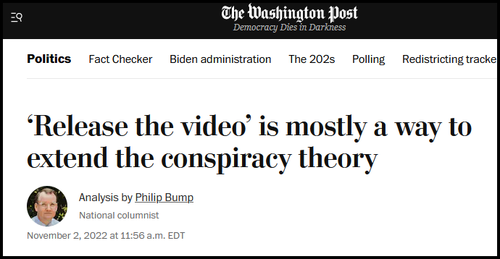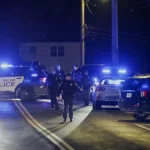
Update (1450ET): The Washington Post - which carries the slogan "Democracy Dies in Darkness" - is now suggesting that people who want to see video of the Pelosi attack are stoking conspiracy theories.
In a Wednesday article, columnist Philip Bump draws a line from 2020 election deniers, to QAnon, to people who think there's something fishy about last week's attack on the Pelosis' San Francisco house by a mentally ill homeless man who was living at a house with a BLM flag, and who back-dated posts on one of his websites after registering it in September.
Bump writes;
The internet makes all of this so depressingly easy. Not only is it a warehouse of information, it is also the corkboard and the colored yarn. You can forage for evidence of your belief system to your heart’s content and you can see how other sympathetic allies have strung together their own theories.
I frequently come back to Lawrence Lessig’s 2009 essay “Against Transparency” in which he warned that publishing information in the interests of governmental transparency would simply give people scads of material to generate their own narratives. That’s exactly what happened, though Lessig didn’t foresee that the advent of social media would vastly speed up the narrative-building process.
As an employee of a newspaper, I would, in fact, like to see the video that the Capitol Police overlooked, and the body-cam footage. It is the media’s job to question authority and to ensure accountability. It is also the media’s job to present accurate information to the public and to stamp out misinformation. So while seeing that footage would be useful, there is not at this point any reason to believe that the attack on Paul Pelosi was anything other than what various legal documents have suggested.
The lure of conspiracy is too strong to accept that, however, and the public understanding of how logic works is too weak. -WaPo
So - people might continue to spread conspiracy theories despite video evidence, so best not to release it.
In closing, Bump puts conditions on transparency; "More transparency and more information are good when considered responsibly. The challenge is that one can no more control how that information is applied than the people who, say, write magazine articles scrutinized for patterns of numbers by the corkboard set can control getting looped into a delusion."
So - no transparency for you, if you aren't qualified to process it.
* * *
Cameras outside the San Francisco home of House Speaker Nancy Pelosi recorded last Friday's break-in, but Capitol Police officers weren't watching the feed at the time, the Washington Post reports.
The Pelosi mansion has more security cameras than the Federal Reserve Bank… https://t.co/T3Is6ylo4K pic.twitter.com/aE84Tel9xx
— NevilleTheCat (@FearTheFloof) October 30, 2022
Instead, officers were alerted to the incident because police lights were flashing outside the house, causing them to rewind the footage and view additional camera angles.
The officer in D.C. quickly pulled up additional camera angles from around Pelosi’s home and began to backtrack, watching recordings from the minutes before San Francisco police arrived. There, on camera, was a man with a hammer, breaking a glass panel and entering the speaker’s home, according to three people familiar with how Capitol Police learned of the break-in and who have been briefed on or viewed the video themselves. -WaPo
So there's not only police bodycam footage, the Capitol Police have footage of the break-in itself - and rewound it to investigate after seeing flashing lights. So, that exists.
And why haven't we seen any of it?
Transparency is the antidote to “misinformation.” Yet for some reason, the San Francisco Police Department is refusing to release bodycam video of the attack on Paul Pelosi. https://t.co/8bFxJgIiRx pic.twitter.com/vmjdYmhoKe
— Tucker Carlson (@TuckerCarlson) November 1, 2022
— Black Swan, The Darkness Consumes (@MarketsPuke) November 2, 2022
The official story, which suspect David DePape has admitted to, is that he was there to kneecap Nancy Pelosi. Instead, he ended up in a fight with 82-year-old Paul Pelosi at 2AM after allowing Paul to use the bathroom - where he allegedly used a charging cell phone to call 911. Paul told the dispatcher that "David" was in the house and that he was "a friend."
Paul Pelosi’s 911 call reveals he knew the man, his name is David and describes him as his friend.
— Derek Utley (@realDerekUtley) October 30, 2022
In the beginning he said he didn’t know him but later, Paul confessed.
The Pelosi’s are not being honest. Retweet so everyone sees this. pic.twitter.com/zRozccWceq
Who is David DePape?
Tucker just took a SLEDGEHAMMER to the fraudulent Paul Pelosi narrative and CRUSHED it in 47 seconds.
— Benny Johnson (@bennyjohnson) November 1, 2022
Wow pic.twitter.com/j9wf0f0gRK
Update (1450ET): The Washington Post – which carries the slogan “Democracy Dies in Darkness” – is now suggesting that people who want to see video of the Pelosi attack are stoking conspiracy theories.
In a Wednesday article, columnist Philip Bump draws a line from 2020 election deniers, to QAnon, to people who think there’s something fishy about last week’s attack on the Pelosis’ San Francisco house by a mentally ill homeless man who was living at a house with a BLM flag, and who back-dated posts on one of his websites after registering it in September.
[embedded content]
Bump writes;
The internet makes all of this so depressingly easy. Not only is it a warehouse of information, it is also the corkboard and the colored yarn. You can forage for evidence of your belief system to your heart’s content and you can see how other sympathetic allies have strung together their own theories.
I frequently come back to Lawrence Lessig’s 2009 essay “Against Transparency” in which he warned that publishing information in the interests of governmental transparency would simply give people scads of material to generate their own narratives. That’s exactly what happened, though Lessig didn’t foresee that the advent of social media would vastly speed up the narrative-building process.
As an employee of a newspaper, I would, in fact, like to see the video that the Capitol Police overlooked, and the body-cam footage. It is the media’s job to question authority and to ensure accountability. It is also the media’s job to present accurate information to the public and to stamp out misinformation. So while seeing that footage would be useful, there is not at this point any reason to believe that the attack on Paul Pelosi was anything other than what various legal documents have suggested.
The lure of conspiracy is too strong to accept that, however, and the public understanding of how logic works is too weak. -WaPo
So – people might continue to spread conspiracy theories despite video evidence, so best not to release it.
In closing, Bump puts conditions on transparency; “More transparency and more information are good when considered responsibly. The challenge is that one can no more control how that information is applied than the people who, say, write magazine articles scrutinized for patterns of numbers by the corkboard set can control getting looped into a delusion.”
So – no transparency for you, if you aren’t qualified to process it.
That’s preposterous. We want the video to see what actually happened. But that’s a great attempt at propagandizing the issue!
— Codpiece of Doom (@Citizen010101) November 2, 2022
* * *
Cameras outside the San Francisco home of House Speaker Nancy Pelosi recorded last Friday’s break-in, but Capitol Police officers weren’t watching the feed at the time, the Washington Post reports.
The Pelosi mansion has more security cameras than the Federal Reserve Bank… https://t.co/T3Is6ylo4K pic.twitter.com/aE84Tel9xx
— NevilleTheCat (@FearTheFloof) October 30, 2022
Instead, officers were alerted to the incident because police lights were flashing outside the house, causing them to rewind the footage and view additional camera angles.
The officer in D.C. quickly pulled up additional camera angles from around Pelosi’s home and began to backtrack, watching recordings from the minutes before San Francisco police arrived. There, on camera, was a man with a hammer, breaking a glass panel and entering the speaker’s home, according to three people familiar with how Capitol Police learned of the break-in and who have been briefed on or viewed the video themselves. -WaPo
So there’s not only police bodycam footage, the Capitol Police have footage of the break-in itself – and rewound it to investigate after seeing flashing lights. So, that exists.
And why haven’t we seen any of it?
Transparency is the antidote to “misinformation.” Yet for some reason, the San Francisco Police Department is refusing to release bodycam video of the attack on Paul Pelosi. https://t.co/8bFxJgIiRx pic.twitter.com/vmjdYmhoKe
— Tucker Carlson (@TuckerCarlson) November 1, 2022
— Black Swan, The Darkness Consumes (@MarketsPuke) November 2, 2022
The official story, which suspect David DePape has admitted to, is that he was there to kneecap Nancy Pelosi. Instead, he ended up in a fight with 82-year-old Paul Pelosi at 2AM after allowing Paul to use the bathroom – where he allegedly used a charging cell phone to call 911. Paul told the dispatcher that “David” was in the house and that he was “a friend.”
Paul Pelosi’s 911 call reveals he knew the man, his name is David and describes him as his friend.
In the beginning he said he didn’t know him but later, Paul confessed.
The Pelosi’s are not being honest. Retweet so everyone sees this. pic.twitter.com/zRozccWceq
— Derek Utley (@realDerekUtley) October 30, 2022
Who is David DePape?
Tucker just took a SLEDGEHAMMER to the fraudulent Paul Pelosi narrative and CRUSHED it in 47 seconds.
Wow pic.twitter.com/j9wf0f0gRK
— Benny Johnson (@bennyjohnson) November 1, 2022





